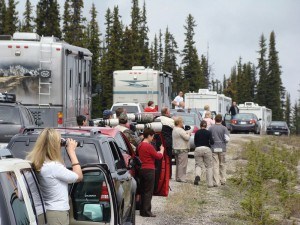
One of Jasper National Park’s greatest treasures is its wildlife. From caribou, elk, moose, bighorn sheep to grizzly and black bears, cougars, wolves, and wolverines, wildlife viewing in Jasper is a truly unique experience.
Visitors travel from far and wide to take in many of these iconic species that make Jasper one of the greatest protected ecosystems in the Rocky Mountains. While wildlife viewing is an integral part of the Jasper National Park experience, Parks Canada’s priority is ensuring the safety of people and wildlife, and our wildlife specialists work every day to help minimize human-wildlife conflict in the park.
For instance, uniformed staff in Parks vehicles conduct daily early morning sweeps of the town of Jasper. They patrol through town urging elk to move to areas outside the townsite so humans and elk remain a safe distance from each other.
Wildlife specialists’ technical skills coupled with their scientific knowledge and adaptability supports their work in various situations, including clearing animal traffic jams. Parks wildlife specialists and Wildlife Guardians help motorists enjoy safe viewing opportunities.
The best advice our specialists can offer visitors is to never leave the pavement to view a roadside bear or any wildlife. Bears foraging along park highways are not tame. These bears may tolerate vehicles and people at close distances, but only because they need roadside food to survive.
People who approach a roadside bear put not only the bear at risk, they jeopardize their own safety and the safety of others. Bear jams also create a traffic hazard—people have sustained injuries from being hit by vehicles at bear jams.
To date, one of the biggest challenges faced by our wildlife specialists is the number of animals killed every year on highways in Jasper National Park—more than 100 animals have been killed in the last three years.
Parks’ actions have greatly reduced human-caused wildlife mortality in the mountain parks, and in Jasper this includes the implementation of reduced speed limits in areas with a higher number of animal crossings, waste management and roadside visitor education. A variety of educational programs are in place to help reduce human-wildlife conflicts in park townsites, campgrounds and other areas.
While Parks works to help wildlife, we cannot act alone and need the public’s help. When visiting the park, we ask visitors to please remember that they are in wildlife habitat. The continued health and survival of wildlife relies on us making as little impact on their home as possible.
Visitor awareness and behaviour are keys to preventing incidents and helping the animals survive. Please slow down and observe park speed limits.
It is berry season soon…
Your chances of encountering a bear on the trail are higher at this time of year.
Berry bushes are found throughout the park, often bordering trails, roads and campgrounds. Bears—black and grizzly—are zeroing in on this critical food source right now.
It is easy to surprise a bear that is focussed on eating berries.
To reduce the risk of a bear encounter:
- Make lots of noise while hiking or cycling on trails.
- Pay attention to your surroundings; look for fresh signs of bear activity, such as tracks and scat.
- Be especially careful near buffalo berry patches.
- If you see a bear, back away slowly and leave the area.
- Carry bear spray and know how to use it.
- Travel in groups.
Parks Canada
Special to the Fitzhugh
